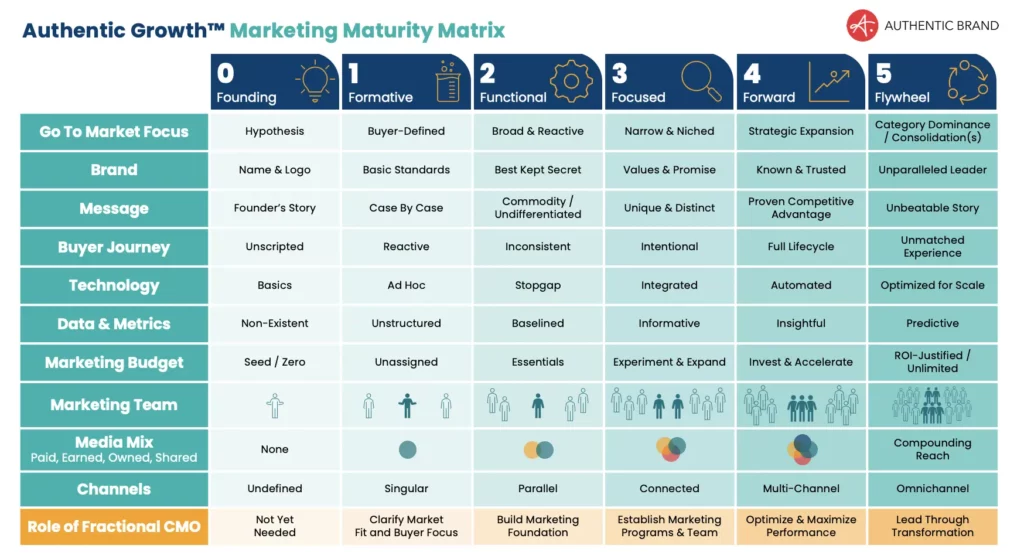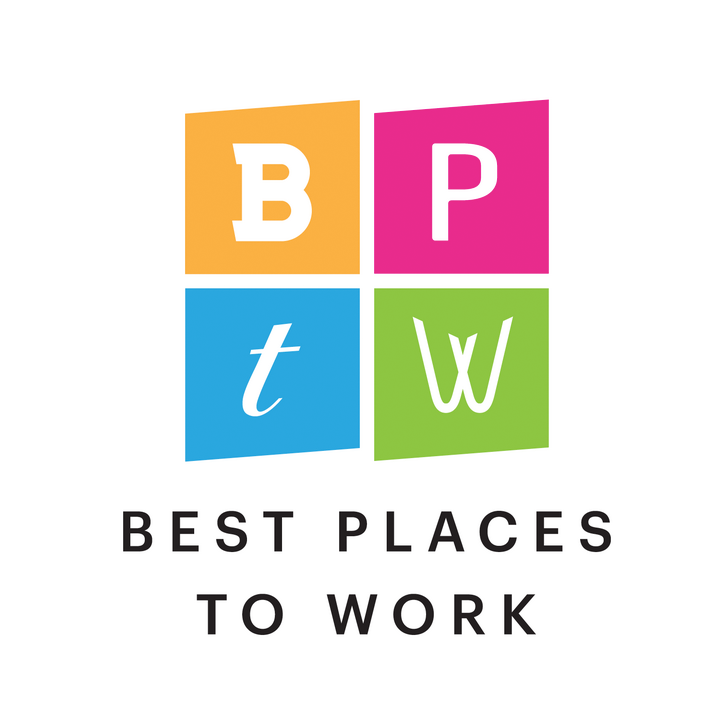
Channels connect your business to your buyers
A company’s first go-to-market channel usually emerges organically as the business finds its footing and tests its idea with the market. But as a company matures, it must thoughtfully choose new channels for growth and develop strategic integrations between them. Using our Authentic Growth® Marketing Maturity Matrix, we demonstrate the stages a business moves through as its channel strategy matures. Before we dive into the six stages of channel maturity, let’s define what we mean by channels.
At Authentic, we think of channels as the broad categories that define a company’s go-to-market approach — the ways in which the business pushes out its brand or pulls in its buyers. If your company were a city, channels would be the freeways that connect your business to those trying to reach it or to those you’re trying to reach. Examples of channels could include outbound, inbound, partner, affiliate, and communities.
Our definition differs from another use of the word “channels”: tactical marketing programs, like email marketing, webinars, digital advertising, social media, and events. These tactics would be the sidewalks and pathways in the city analogy. In other words, the routes that directly connect with specific audiences. In the case of our maturity matrix, we categorize these tactical programs into the media mix column.

The path to omnichannel excellence: Stages 0 to 5
Every business strives to create a seamless brand experience spanning multiple channels. But the journey to omnichannel excellence isn’t simple or quick. Charting and paving the paths of an effective strategy requires you to place bets on what will work best for your business, iterate as you learn, and thoughtfully integrate teams and channels.
The following six stages demonstrate how businesses mature their channel strategies.

Stage 0: Founding – Undefined
Most founders don’t go into business with an intentional channel strategy. Instead, they start with a hypothesis or beta concept they want to test in the real world. The founders may not realize it then, but in the earliest days of the business, they are likely tapping their first channel: their network: the people who know, trust, and want to support their business.
The founder’s network, which is what Authentic may categorize as an “executive referral channel,” is often the first channel for founder-led businesses. However, every organization will need to consider what go-to-market channels make the most sense for the company and how they want to refer to those channels.
How to mature to the next stage: You’re still in a hypothesis-testing phase, even as you move to the next stage. It’s normal not to be able to define your ideal buyer yet, but now is the time to start noticing early clues about what’s working well and for which type of buyer. Consider whether you know anyone else who might fit the mold of who you think your ideal buyer might be, and explore how you can continue to test your hypothesis. Start to think about how to build your network beyond those who already know and trust you.
What you’ll need: A willingness to test your early hypothesis by meeting with various connections and an appetite for questioning your assumptions based on what you learn.

Stage 1: Formative – Singular
At this stage, the business is gaining momentum, has customers, and is trying to determine which direction to go next. The go-to-market focus is still very loosely defined, but the founding team is becoming more intentional about nurturing its initial channel. For example, the founder is likely networking to form new relationships with people they didn’t know before starting the business but who might be able to help the company grow.
This is also often when the business hires its first sales rep to help get its message and solution to more prospects.
How to mature to the next stage: Continue to look for opportunities to connect with people who can help your business grow, building a “black book” of connections who may be able to support you by providing you with feedback or potentially even new business. Iterate on your message, refine your product or service as you get feedback from the market, and narrow in on your market position.
What you’ll need: To expand your network beyond those who already know and trust you. Do this by participating in founder peer groups, industry events, and many “coffee meetings” to share your business model and ask for feedback.

Stage 2: Functional – Parallel
You are beginning to achieve operational critical mass: you’re an established business and have more clarity on the problem you solve, who you’re solving it for, and what makes you unique in your market. Now is the time to reach people who don’t know the business by building your next channel. For example, you may focus on strategic referral partnerships or launching inbound programs that you support with thought leadership content and a digital presence that attracts qualified buyers.
Choosing which channel to build next isn’t a simple decision. There are a lot of good, viable paths to take, but there isn’t enough historical data to guarantee the success of any single channel. Plus, most businesses do not have the resources (time, energy, or money) to tackle multiple channels simultaneously. The key is to have confidence in the bets you place and a way to track, analyze, and refine as you go.
How to mature to the next stage: This is a great time to bring in the wisdom of an experienced marketing leader to help you consider all channel options to choose the one with the greatest likelihood of success. A leader who has “been there, done that” can help you map out your next channel strategy and recalibrate as you learn.
It’s also critical to understand what resources, including the budget and talent, you’ll need to support your chosen channel. For example, if your next channel is strategic referral partnerships, do you need to hire a partner or alliance leader to build relationships with your partners? If your next channel is inbound, do you need to hire a content leader who understands how to create content programs that attract quality leads? Do you have enough budget to support that content’s production, distribution, and promotion?
What you’ll need: An appropriately sized budget and a strategic marketing leader who has helped build a business similar to your business model. This leader can help you choose which channel to pursue next, allocate resources accordingly, and determine how you’ll measure success.

Stage 3: Focused – Connected
At this point in channel maturity, you should have at least one proven, stable channel of growth with 1-2 other channels in development and testing. Your marketing programs and systems supporting these channels have been ad hoc, reactive, and siloed until now. You’ve been experimenting with what content, engagement cadence, and management resources each channel needs.
But now, as the business allocates more money toward growth, the marketing function needs to mature to higher productivity, automation, integration, and data-driven decision-making. For example, when measuring channel performance, many companies get distracted trying to measure content or campaign performance. But what matters even more is how your channel influences your overall pipeline. For example, your paid channel may drive many leads, but they’re not necessarily high quality. Meanwhile, your partnership channel may drive far fewer leads, but they are far more qualified than most leads from your paid channel. These insights are critical to optimizing your channel strategy.
How to mature to the next stage: Create a plan for each channel that aligns with the overall marketing strategy. Understand which stakeholders you’re reaching with each channel, their needs, and how to support them best. Create content, resources, and programming that engages these audiences, and figure out ways to optimize these channels to drive high-quality, relevant leads.
While each channel needs its own strategy (and potentially its own mix of staff to support it), the channels should connect strategically, aligning with your business vision and brand. Ensure channel leaders collaborate to brainstorm ways to leverage content and programs created for one program in another channel.
What you’ll need: To understand the stakeholders you serve through each channel and the right media mix to support and engage them.

Stage 4: Forward – Multi-channel
In this stage, your marketing plan has shifted from being one-dimensional (one-size-fits-all content and events) to being thoughtfully customized to each unique channel and stakeholder (e.g., prospects, current clients, partners). You have become more intentional about maximizing all of your marketing investments by repurposing your content and packaging it in a way that serves the intended audience.
For example, you can leverage a client success story across multiple channels: in your inbound programs, you can use it to help prospects understand how your solution could serve them. In your client retention channel, you can share the success story within that same client company to expand engagement within the account. And with partners, you can share it to educate them on how you create value for shared customers.
How to mature to the next stage: Brainstorm ways to better integrate and optimize your channels. Maximize your investments in content, resources, and programming by extending them to other channels. This ensures that you’re leveraging your overall spend across the channels in a harmonious and thoughtful way so you don’t double or triple your investments to serve individual channels.
What you’ll need: Data and insights to assess and optimize channel performance, technology that integrates between channels, and regular collaboration between the different channel teams to build seamless integration and experiences.

Stage 5: Flywheel – Omnichannel
Businesses that have reached this final stage of channel maturity have thoughtfully embraced multiple channels for growth. They have optimized each channel and are now focusing on creating greater levels of integration and brand experience across them.
While multi-channel implies using multiple or many channels, omnichannel takes things to the next level with seamless integration and brand experience across channels. (It’s worth noting that we aren’t referring to omnichannel media, which would mean, as an example, a seamless customer experience between your TV ads and your in-store experience. Rather, we’re talking about the broader ecosystem of marketing systems that grow your business.)
All channels and their respective teams are operating as one revenue organization, unified by a vision for how it will support growth.
How to continue maturing: Stay responsive to market changes and emerging channels that could expand your reach. Continually optimize your media mix and integration of channels.
Build an integrated channel strategy to drive growth
There are many directions a business could take with its channel strategy, which provides both a lot of potential and room for error. Ultimately, a company’s channel strategy should stem directly from the business vision and growth goals. An experienced marketing leader can help connect all this for your business, helping you build and integrate the channels that will best fuel your success.
At Authentic, our team has helped businesses of many types and sizes achieve omnichannel excellence. Reach out if you’d like to learn how an Authentic Fractional CMO™ could bring our proven methodology to your business and help you take the right next step.








